中文 SQES Master 培训教材
- 格式:pptx
- 大小:1.71 MB
- 文档页数:27

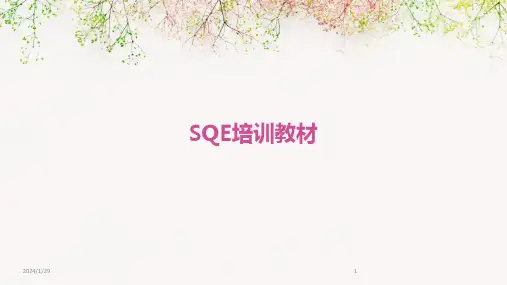

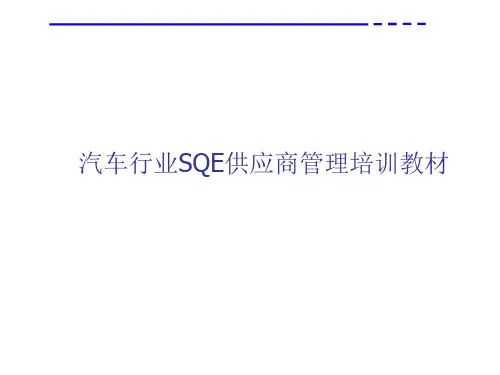


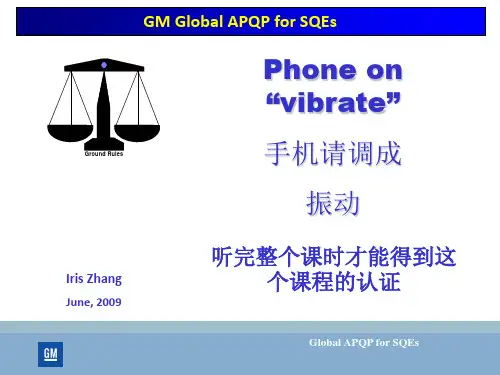
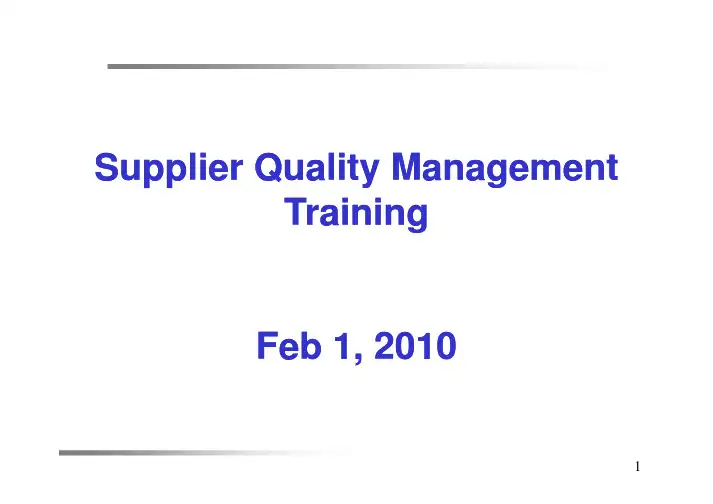
Supplier Quality Management TrainingFeb 1, 20101SQE Roles and Responsibilities2Supplier Quality Engineering Roles/ResponsibilitiesWork Effort-Survey -New Product Plan/Scorecard (NPP/SC) -Supplier Quality Agreement (SQA) -Quality Systems Audit/Process Audit Mgt (QSA/QPA) -Quality Management Plan Dev/Final (QMP) -Quarterly Quality Review Mgt (QQR)-Survey -QMP/MQT Input -Conducts QSA/QPA -Supplier Quality Std Comm. (SQS) -New Product Readiness Rev. (NPRR) -Continuous Improvement (CIP) -LFR Mgt-In Training -OEM Factory-Supplier Link -CIP -Excursion Mgt -LFR MgtProduct Development Cycle 3Quality System Overview4Supplier Quality System The Basics Steps#1. Relationship #2. Process #3. Performance #4. Improvement5The Quality SystemSupplier Quality RELATIONSHIPSupplier Quality PROCESSSupplier Quality PERFORMANCESupplier Quality IMPROVEMENT•Supplier Survey •Supplier Quality Standard (SQS) •Quality Agreement Business Relationship•Quality System •Yield/Line/ Field •Closed Loop Audit Metrics CA System •Process Audit •Daily,Weekly, •Continuous •Quality Mgmt Monthly Improvement Plan/MQT Reports Process (CIP) •PPAP •Quarterly •New P-Plan & Quality Review Scorecard (QQR) •Safe Launch Process Customer Drive Change Establishment & Experience Qualification6Quality System FlowNegotiate Quality Commitment Exchange Quality GoalsPROCESSNPP/SC Start Audit MFG. Facilities Review Design & Lessons Learned Create Quality Management PlanShare Quality Expectations Identify Potential SuppliersRELATIONSHIPImplement Corrective ActionsTrack Lessons LearnedNEW SUPPLIER AND/OR TECHNOLOGYIdentify Improvement OpportunitiesEXISTING SUPPLIER AND/OR TECHNOLOGYSafe LaunchIMPROVEMENTReview Performance w/ Supplier Monitor Supplier Line PerformanceQuarterly Business ReviewsEvaluate Total Customer ExperienceMonitor l Line & Field Perform.PERFORMANCE7Selection Process FlowPerform Supplier Survey SQE with new supplierShare Supplier Quality StandardSQE with SupplierPerform Quality Systems AuditSQE with SupplierPerform Process AuditSQE with SupplierSet Quality Goals with SupplierSQE with SupplierNegotiate Quality AgreementSQE with Legal Team & (Supplier Legal Team)Supplier Selection must be completed prior to moving to the management phaseSupplier Selection DecisionSQE / Business Team8Management Process FlowSupplier Management starts after supplier selection is completedQuality Mgmt Planning (OEM and Supplier) SQE leadsNew Product Plan and ScorecardSQE leadsPPAP, Production Part ApprovalSQE leadsPerform Process Audit (if not done earlier)SQE leadsSafe LaunchSQE leadsManaging / Monitoring Supplier Quality Performance Supplier Corrective Actions Supplier-Related Engineering Changes SQE leadsQuarterly Quality ReviewsSQE partcipates with OEM Management TeamManage Continuous Improvement ProcessSQE leads9Supplier Relationship Step # 1 “ Business Relationship”10Perform Supplier SurveyShare Supplier Quality StandardNegotiate Quality AgreementDecisionSupplier Quality ProcessStep # 2“ Process Establishment &Qualification”Perform Quality Systems AuditScorecardApproval ProcessPerform Process AuditNPI Readiness Review New Product ReadinessSupplier QualityPerformanceStep # 3“Customer Experience”Daily/Weekly and Monthly Reports Supplier QualityPerformanceSupplier Related Engineering ChangesQuarterly Quality Reviews (QQR)Supplier Quality ImprovementStep # 4“Drive Change”Customer ExperienceResults of SuccessCIPIFIRLRRYieldContinuous ImprovementDrive Quality @ the Source through...Quality ImprovementTotal Quality ProcessFoundation and Enabler toSuccessQuality Systems Qualityby Design Quality Improvement Process -Prevention Early Supplier InvolvementSub-Supplier ManagementSupplier Total Quality Ownership CIPAction that Drives SuccessSupplier CorrectiveThe CIP ensures the quality results targeted for a Managing CIPSafe LaunchThe Need and Key’sWhy do we need Safe Launch?Safe Launch is used to insure a quality product launch and a qualitypost RTS rampReduce STOPBUILD/STOP SHIP occurrences after the release of a new productKeep our customer commitmentsWhat are the major keys to implementing Safe Launch?Gates/Checkpoints are established throughout development,implementation, & deployment phasesExit criteria must be met in order to pass through the Gate/CheckpointResults & BenefitsResults and BenefitsSafe launch has proven beneficial –data talks!Field incident rate (FIR) improvementFactory data improvementContinuous improvementsApplying lessons learned to next generation products Improved and sustained process capabilitySAFE LAUNCH PROCESS DETAILSResponsibility and Authority/Using Safe LaunchWho is responsible for carrying out the process!SQE who is managing the product/program is responsible forimplementation and adherence to the safe launch processSafe launch should be used in the following situations.New productNew Manufacturing facility, existing supplierNew SupplierSignificant form/function changes to existing productMultiple Line qualification with existing productCritical processes to be monitoredDefine processes. Examples for a PCBA include:Post Reflow VMITouch up VIICTFVSOBEBuild QuantitySet pilot and controlled ramp quantitiesStart with small quantity and work up to overall rampExamplePilot phase 1, 5 pieces; phase 2, 50 pieces; phase 3, 250 piecesControlled Ramp, week-1 day-1 will be 250, day-2 350, day-3 450..and so onYields and GatesSet by both SQE and SupplierOnly first pass yields will be usedPilot gates will be set and remain the same through all 3 phasesControlled ramp gates will be set an increase by phase week until final goals are metGate Rules and Corrective actionsManufacturing will be stopped as soon as gate has been violatedBuilds will have to be repeated until gate is metAll corrective actions will be closed before advancing to the next build Safe Launch will be exited once all gates are met for 4 consecutive weeksData Collection and ReportingSupplier required to monitor process real timeSupplier will stop building immediately when the gate is violated Safe Launch Pilot and Controlled Ramp Data Collection Templateand Action Plan Register, will be used for all buildsSupplier will provide a daily summary report for each build/phase immediately after it is completed through the safe launch periodData Collection and Reporting TemplateOverall Tool KitReviewAVL _ Supplier Survey and AuditQuality Performance 4-Up ChartsItem Issues DPPMDec.DPPMNov.Root Cause Action Request1 2 3SCAR _ Supplier Corrective Action Request Cycle Time and effectiveness follow upQBR Supplier RatingDESCRIPTION:0.00 Dim. Designator30FAI #:CIFICATIONSINCHMM。
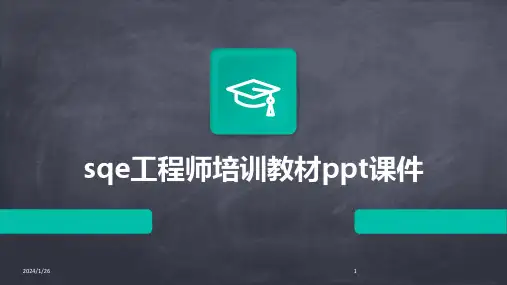
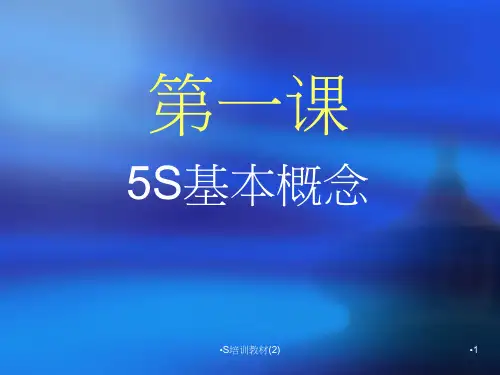
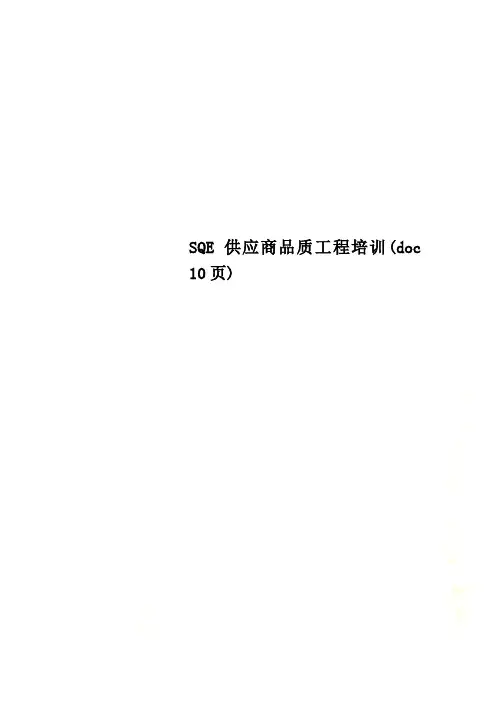
SQE供应商品质工程培训(doc 10页)SQE(供应商品质工程)有两方面的工作:一是供应商的品质控制方面,二是企业内IQC工作的品质控制;SQE的工作还包括:1.建立合格供应商管理系统;2.供应商评审系统,包括供应商体系审核表和评分标准;3.IQC品质保证系统的建立,包括IQC运作流程、技术标准以及检测方法;4.制订不合格批处理程序,其中包括各种特殊情况的处理方法;SQE最重要的能力就是建立各种品质保证体系的能力,通过各种品质保证系统的有效运作,使得企业所有的物料的品质得到保证;系统的建立和完善是SQE首先要完成的,不然的话,很容易成为繁忙的消防队员。
SPC统计的手法是品质管理的基本技能和方法,实际的品质管控工作,其实不管你有没有导入这些统计手法,其实你都在运用,只是没有系统化而已。
比方说,你的检验员在对产品进行抽检时的尺寸测量,2小时一模的抽检频率,这个频率就是一种统计方法。
当出现了不良品,我们得分析一下不良的原因,一个班生产了1万只产品,有500只不良,不良率5%。
再细分,缺料200只,划伤250只,黑点50只。
这时可以导入鱼骨图来找原因了,从人、机、料、法、环的各个因素去找原因,再改善。
QC七大手法其实在检验过程中就体现了,导不导入都在做。
做的好不好,有没有效而已。
SPC则是一个系统工程了,需要投入软硬件才能见效。
硬件是人员、设备的配备,测量是SPC数据的来源,所需数据测量工作非常繁重。
软件的投入是整个管理体系得建立问题改善团队,这个说得容易,做起来很难,很多推行不了的原因就在此。
SPC是控制制程稳定性的,当我们根据数据判断出制程可能出现不稳定因素时,怎么去改善它,才是SPC的真正目的。
没有一个完善的管理体系和规程,往往弄到最后就变成了一种装饰,应付某种需要存在的工具。
品管七大手法:检查表——收集、整理资料;排列图——确定主导因素;散布图——展示变数之间的线性关系;因果图——寻找引发结果的原因;分层法——从不同角度层面发现问题;直方图——展示过程的分布情况;控制图——识别波动的来源;PDCA _计划实施检查改进SPC- (Statistical Process Control):为了贯彻预防原则,应用统计技术对过程中的各个阶段进行评估和监察,从而保证产品与服务满足要求的均匀性。